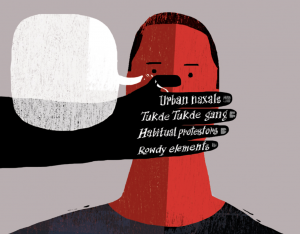In 2020, put people first: Protesters are not ‘urban naxals.’ Government needs to listen to them
Source: The Times of India / www.timesofindia.com / By Sagarika Ghose /
“Go to Pakistan,” a senior UP police officer was recently heard telling anti Citizenship (Amendment) Act protesters in Meerut. A supposedly neutral law enforcer uttered a shocking, outrageous threat, yet why blame the police officer alone? All through 2019, critics, dissenters, protesters have been met with such refrains, hurled from the highest political quarters.
Home minister Amit Shah referred to Delhi protesters as tukde tukde gang who must be taught a lesson by the people. Prime Minister Narendra Modi accused urban naxals in a speech in Delhi. Minister Giriraj Singh has often exhorted dissenters to ‘go to Pakistan’. As a new decade begins, the Modi government needs a new approach and lexicon towards those who disagree and protest. No, protesters in a democracy are not urban naxals, or tukde tukde gang nor should they be told to go to Pakistan.
The stereotyping of anti-CAA protesters as ‘Pakistani’ or bearded men in skullcaps, is designed to cast protesters as enemies of the people. It’s a misreading of the fact that many anti-CAA protests have been dignified citizens’ movements. Yes, bloody clashes between police and protesters in UP have cast a shadow. But from slum dwellers in Dharavi to teachers and students of Delhi University, writers and historians in Bengaluru, women in Delhi’s Shaheen Bagh to middle class professionals and film personalities in Mumbai, a wide range of people have participated, often spontaneously and creatively.
Citizens have gathered, devised posters and street plays in the best traditions of non-violent, democratic, civic movements, it’s been a mobilisation dominated by youth. The protests have been an example of what Vaclav Havel called the “parallel polis” – civil society set apart from politicians. Apart from UP and Mangaluru, the overwhelming majority of rallies have remained peaceful.

That UP and western UP in particular has been the flashpoint for violence should come as no surprise. Over the last decade, UP has witnessed harsh religious polarisation. Riots tore through Muzaffarnagar in 2013 and many of those accused of rape and murder have been let off. UP chief minister Yogi Adityanath, once the poster boy of militant Hindutva, has so far uttered no word of empathy for the over 20 dead. Instead, he has justified the merciless police crackdown, vowing that rioters will “cry” under the Yogi government.
Hoarding and use of illegal firearms by Muslims must be investigated. But it is also true that over the last two years, Muslims have felt systematically targeted, many businesses in meat, brass and leather have been destroyed and the community has been politically isolated. While a few IPS officers have tried to reach out, the lower and middle constabulary seem to be evoking images of the 1980s when during a spate of riots, the UP police was accused of brazen communalism.
India inherited from the British Raj a highly centralised, coercive police state, a dangerously over-extended structure which Gandhi constantly warned against. Always an opponent of the big centralised state, the Mahatma said: “Centralisation as a system is inconsistent with a non-violent structure of society … centralisation cannot be sustained and defended without adequate force.” The centralised state perpetuates and normalises violence between citizens because it enforces its will through violence.
The anti-CAA protests have seen the coercive state in full force. In UP, instead of disciplinary action against excessive policing, the government has responded by repeatedly imposing Section 144, preventing public gatherings. It has clamped curfew, repeatedly shut down the internet and even used stun-grenades against AMU students.
Delhi police used facial recognition technology to identify “habitual protesters” and “rowdy elements” to keep out of the PM’s Delhi rally. A German student was sent back to his home after he took part in protests and a Norwegian tourist was also asked to leave. The Tata Institute of Social Sciences put out a circular stating that since the institute is government funded, staff and faculty were barred from joining protests while on duty.
Yet democracy by definition is a recognition of the legitimacy of dissent. A massive electoral mandate cannot be used to de-legitimise dissent because electoral majorities being temporary, today’s powerful establishment could be tomorrow’s powerless protester; today’s majority opinion could be tomorrow’s minority view. That’s why democracy cannot be interpreted as majoritarianism, because majorities keep changing at most elections. Democracy instead is the art of disagreeing well.
Every government from AB Vajpayee to Manmohan Singh has sought to provide protection to ‘persecuted’ religious minorities in the neighbourhood. In 2003, the Vajpayee government brought in major changes to the Citizenship Act of 1955, introducing the words “illegal migrants” and “national register for citizens”. Importantly, the parliamentary committee on Vajpayee’s Citizenship Bill was headed by Congressman Pranab Mukherjee and there was political negotiation and consultation across party lines and across ideological divides. The Citizenship (Amendment) Bill 2003 was passed without fuss or public tumult. Because he was a believer in dialogue, Vajpayee was trusted. Manmohan Singh too was a conciliator, moving to build trust through consensus. It is a skill the Modi-Shah duo seem to singularly lack.
The BJP-led Big State believes in high-voltage bulldozing of legislation without any consultation. Dialogue is seen as ‘weakness’ and does not fit the image of a ‘muscular’ government. Yet the key to delivering good governance is to build trust. As a new decade begins, the Modi government needs a new approach for citizens who dissent and disagree. If 2019 was the year of too much government, 2020 should be the year of the citizen.

